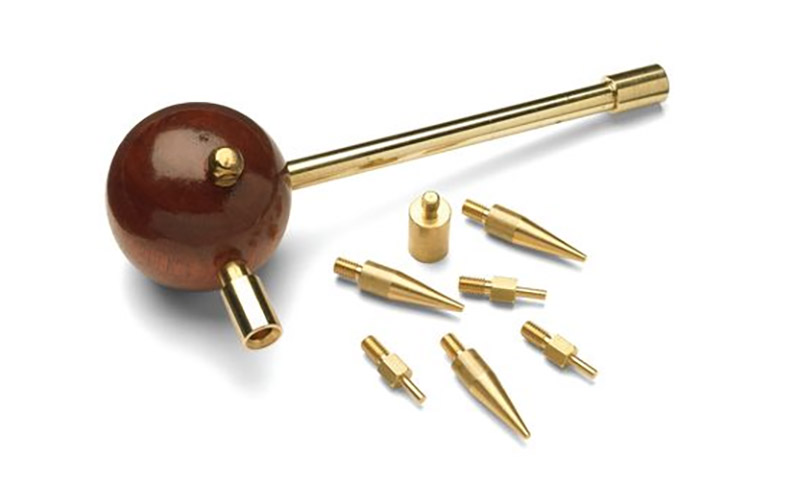Muzzleloader technology may be old, but it’s far from useless. Here are a few of the best muzzleloader options for the hunt.
There’s something about a muzzleloader that inspires a sickening form of nostalgia. There is just something so right about sitting in the woods with a light flurry of snow in the air and a warm pot of chili waiting for you back inside. Rarely does the image conjure with a modern gun made of machined aluminum and chambered in this year’s fad cartridge. Instead, the most appealing aspect of this fantasy involves a soot-stained walnut stock that’s cradling a patina-covered barrel.
It isn’t just about the sit or the shot, rather the entire experience of hunting with a muzzleloader: the smoke, grease, and acrid flavor of the air after your one shot goes off. Hunting with a muzzleloader doesn’t have to be a fantasy of yesteryear, but just like in those halcyon days, it will be a tremendous challenge.

Traditional Vs. Modern Muzzleloaders
Muzzleloaders can be generally broken down into two groups: traditional and modern. While there are indeed traditional guns made with modern materials such as synthetic stocks, what really makes them different is their priming method. The traditional guns have an exposed lock, either flint or percussion. To prime these guns, you must either pour powder into the pan or place a cap on the nipple, respectively. Modern in-line muzzleloaders usually have a break action that allows a shotgun-type 209 primer to be inserted. When closed, this primer is protected from the elements. As can be imagined, the side-lock traditional guns are more susceptible to moisture and bad weather. The different ignition types are the main distinction, but there is much more to consider when deciding what kind to buy and hunt.

There is a great divide between proponents of traditional and modern muzzleloaders, and they’ve even been known to disagree on what exactly constitutes a muzzleloader to begin with. The traditionalists maintain that the exposed hammer side-lock, either percussion or flint, is the only way to really do it right. This school operates under the impression that there is a spirit to the hunt, a worthy challenge that demands adherence to tradition and old methods. Among traditionalists, there is a prevailing view that modern in-line muzzleloaders are designed to skirt the spirit of the hunt and introduce modern materials and methods that give the hunter the same or similar advantages to hunting with a regular centerfire rifle in, say, .45-70 or .30-06.
There is some merit to this, as aside from loading from the muzzle, there are few similarities between traditional muzzleloaders and modern in-line rifles. While there are of course some types of crossover models, the traditional muzzleloader can be thought of as a primitive, individual weapon in respect to its style and ammunition, whereas the modern ones can be thought of as standardized systems that just use a slow method of reloading. Modern muzzleloaders are in fact very, very advanced and can offer accuracy better than 1-inch for three shots at 100 yards. A great deal of research and testing has gone into making the pre-weighed powder charges, bullets and sabots as consistent and easy-to-use as possible. Again, while not as easy as a cartridge gun, modern in-line rifles are substantially faster and more accurate than traditional muzzleloaders.
Muzzleloader Accessories Worth Having
Since there is such a large degree of difference between traditional and modern muzzleloaders, their accessories are not exactly the same either. However, there are some universally useful items for both types and specialized tools for both traditional and in-line muzzleloaders. The first of these is a range rod, a longer, more easily used ramrod that facilitates faster loading during practice. While it may seem like a waste considering that muzzleloaders come with a ramrod, the ones stowed on the gun are really for field use. Traditional muzzleloaders often have a wooden ramrod and, while historically accurate, are quite fragile. Range rods are usually thicker and made of a durable polymerized material or nylon and have interchangeable ends to load different bullet types. Range rods can also be fitted with jags for cleaning.
Another great universal tool is a bullet starter. Because the bullet and patch/sabot fit very tightly in the bore, it takes considerable force to get them started. This is also a time when the bullets can become deformed from repeated strikes against their tip or exposed surface. While it is not impossible to load using just the ramrod, it is awkward at the very least and can become frustrating if you are trying to load in a densely wooded area and keep getting your rod caught on branches. The bullet starter is basically just a wide, comfortable ball with a peg that is used to knock the ball in the first three inches or so. Many hunters carry this tool on a lanyard around their neck as to not lose it in the field.
When it comes to specialty gear for traditional guns, you’re going to want to make sure you have a safe way to carry your loose powder, balls, and patches. The thing about these guns is that there isn’t really a good way to make cartridges for them and achieve any real accuracy; about the best you can do is pre-measure your powder and roll your own paper cartridges using a dowel rod and some tape. Even then, this isn’t necessarily faster than just pouring from a powder horn or flask and individual paper packets can more easily get exposed to moisture. It should be noted that unless you are loading with paper that is instantly combustible, you shouldn’t be ramming the entire packet down the barrel. What the old-timers call a “possible bag” is a good choice for carrying these items and has been used throughout history.
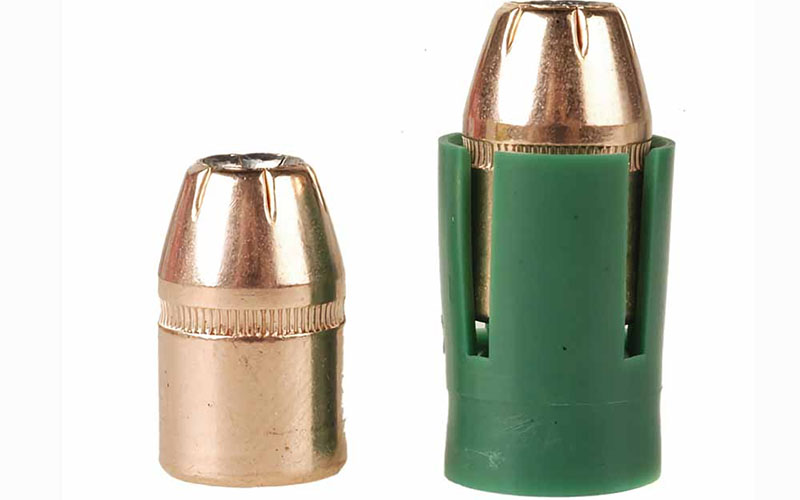
Modern in-line muzzleloaders can take advantage of ready-made sabot rounds that are comprised of cylindrical-shaped columns of powder around a plastic sabot that contains the bullet. They can be carried in plastic tubes and are ready to load instantly. Simply stick the powder end in and start the sabot and it will slide down the barrel. It is very, very fast and, while not as fast as a cartridge rifle, it is ten times quicker than the traditional method with loose powder and patched balls. Because they are essentially modern guns, in-line muzzleloaders can often be outfitted with optics, bipods and other modern accessories without issue.
Performance Details
Today’s technology has allowed the muzzleloader to become a precision instrument. It is fully possible to use a high-end in-line to make clean kills out to 300 yards and beyond. While still not ideal for long-range shooting, a hunter armed with an in-line muzzleloader has very good odds of putting meat in their freezer.
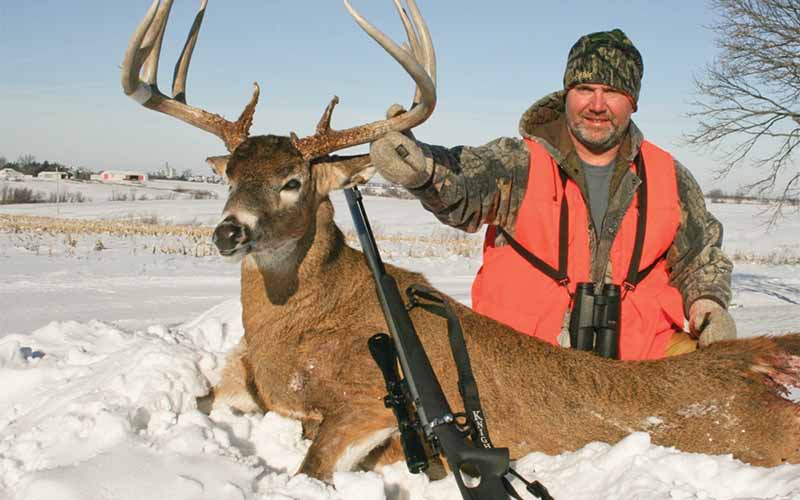
A great deal of effort has gone into making the modern in-line a high-performance antique. In reality, the muzzleloader has been obsolescent since before the Civil War, as breech-loaders and cartridge rifles were already in production at that time. The black powder era would see the first bolt action rifles, lever guns and even machine guns. As far as muzzleloader technology goes, it effectively stopped advancing in 1865. When muzzleloaders became popular again for certain hunting areas and seasons, they were reimagined through a new lens and became what we have today.
In setting regulations for hunting seasons and preventing overhunting, many agencies began implementing primitive seasons, resulting in the muzzleloader growing in popularity once again. This phenomenon dates back to the 1950s and ‘60s with America’s fascination with its frontier past. Some states even went so far as to mandate flintlocks with no optics as part of their initiative, such as Pennsylvania. While it may seem extreme to limit one to such a primitive gun, what it really does is remove all the modern advantages of the in-line and forces the hunter to get much closer.
Of note is that the traditional muzzleloader isn’t at all a weak-sauce rifle and is in fact exceedingly powerful for the task at hand, even for large game. When making a load for the traditional rifle, 100 yards is certainly in the envelope of performance. Beyond that, however, things drop off rapidly, both literally and figuratively. The trajectory of the patched round ball leaves much to be desired, however, if zeroed for 100 yards any shot inside that and out to 125 yards should achievable when using the same hold. The most common calibers are .45 and .50 for the traditional guns, but .54 and .58 are extremely effective too. There is some debate over whether .58 is really better given that it is not necessarily faster at the same ranges as .54-caliber, and is not especially heavier. A .54-caliber patched ball will get the job done at 100 yards on most, if not all, large game species.
Why The Muzzleloader
When picking a muzzleloader, you must first ask yourself what you intend to get out of the hunt. A traditional muzzleloader is a somewhat difficult rifle to master, as a substantial amount of individual attention must be paid to it to make it shoot well. Even then, it is limited to an effective range of 150-yards at a maximum, and 75-yards is far more ideal. If using a 1750s-style flintlock long rifle appeals to you, you need to devote a considerable amount of time and energy to get that rifle to perform at what is essentially one-quarter of the effective range of a modern in-line muzzleloader.
The appeal of the traditional muzzleloader is not in its long-range killing ability, but rather what it inspires in the individual hunting with it. Virtually all those that hunt with such a gun are not hunting to fill the freezer. Instead, they want a certain experience out of the hunt. They want to feel more attached to the land and the game and to feel what hunting was like in the age of their forefathers. In some areas of the country, there are flintlock-only seasons, but these don’t account for the majority of flintlock owners by any stretch. Conversely, the appeal of the modern in-line muzzleloader is precisely its ability to put meat in the freezer, as it is hardly different in terms of accuracy and handling compared to a common centerfire rifle.
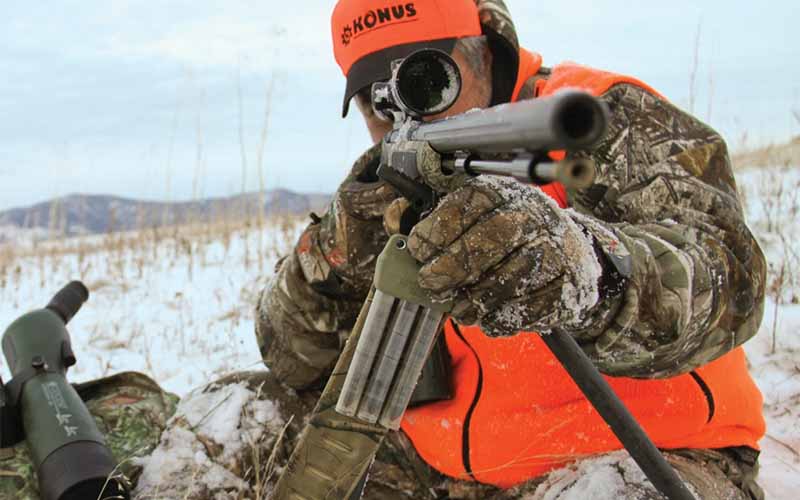
Knowing a traditional muzzleloader will be less efficient in the field is a handicap that some are willing to accept. Due to the fact that scopes of any kind are rare on flint and cap locks, a major limiting factor is the iron sights on the rifle itself. Shadows at dusk can completely ruin a sight picture and, unless you’re using fiber optic sights, there is not much of anything that can be done to create contrast between the sights and game. This is further compounded with distance. If using a flintlock, you will almost certainly lose sight of the game upon firing, making the precision of the iron sights even more important. You want to ensure that your shot placement is as good as can be, and to gain that with iron sights and a side-lock you will need to close the distance considerably.
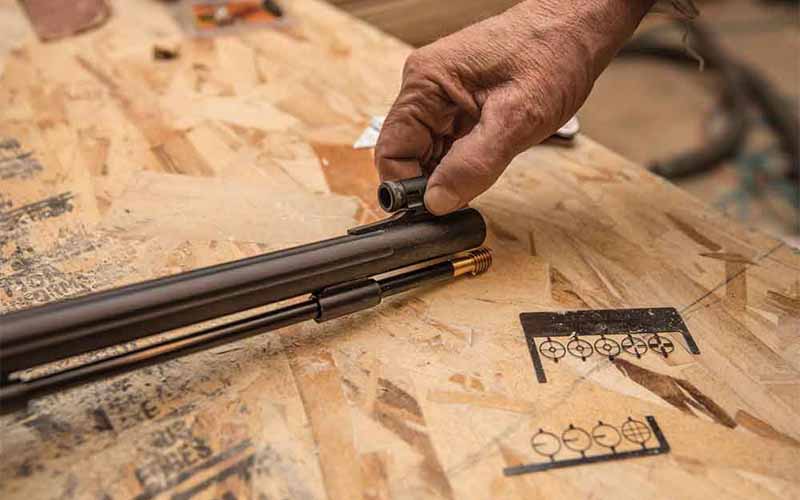
It is safe to say that the modern in-line is a hunting tool, not a nostalgic element of our past. This type of muzzleloader mostly exists to increase efficiency while still playing by the rules of muzzleloader-only seasons. In reality, they are modern guns with modern accuracy that simply load in an antiquated way. You will have a greater likelihood of putting meat in the freezer with an in-line as a matter of the bullets alone; flatter trajectories and high-tech projectiles mean you’ll have more chances to make a hit at all distances where the bullet still carries energy. If you are a meat hunter or want that trophy buck, you’ll probably want an in-line.
Discussion On The 209 Primer
The 209 shotgun shell primer is a common, very reliable means of ignition. By adapting its use for Muzzleloaders, not only was ignition efficiency increased but it also increased accuracy with a more even burn rate. The use of the 209 primer as opposed to other ignition sources has allowed a great many advances in muzzleloader technology, including the pre-made powder pellets common to their sabot loads. A more consistent burn means a more consistent velocity leaving the muzzle, and virtually all modern muzzleloaders will shoot inside 2-inches at 100 yards using 3 Pyrodex-loaded pellets.

Another advantage to the use of an enclosed priming system is that there is no flash on the side of the gun and no pieces of the cap or spark that can come back into your face like on a side-lock gun. A large reason why a flintlock is hard to master is that you quite literally have to deal with powder exploding inches from your eye. Flintlock shooters as a result usually go for set triggers on their guns. Keeping the trigger pull as light as possible helps keep the sights on target as the gun fires, which can take an entire second in some cases. This is yet another reason why the modern in-line is far more similar to a centerfire rifle than its sidelock cousins.
Discussions On Powder
Real and true black powder is still relatively common and can be found on shelves all over the country, but it is not the primary choice for muzzleloader enthusiasts these days. Black powder substitutes are abundantly common and far easier to clean up after. They also generate less smoke than pure black powder. As far as performance goes, there isn’t too much difference in the results on-target; it is far more about the overall user experience.
If you want the truest experience or to have a historically correct piece, you may want to go with real black powder. With a modern in-line, it is the safest bet to go with pellets and sabots. This will maximize the performance of your modern gun and let you stretch it out further and with greater accuracy. For shooting at iron-sight distances using a flintlock or percussion gun, there won’t be a noticeable difference in accuracy in a practical sense. Some European varieties of true black powder are made to an exceedingly high standard and can deliver better accuracy than off-the-shelf substitutes, though they can be harder to come by in the States.

Black powder substitutes like Pyrodex generally behave in the same way as real black powder and loads identically in that it needs to be compressed under the ball to provide a clean burn. Substitutes have a reputation of not being great in flintlocks because they seem to not ignite as readily from the shower of sparks generated by the flint itself. Shooters wanting a cleaner flintlock experience will sometimes load the main charge using a substitute and prime the pan with fine true black powder. This seems to alleviate any ignition problems with flintlocks, but this solution really does depend on the quality of the lock and flint as much as the powder being used to prime.
Muzzleloader Care
Despite being so simple, muzzleloaders are relatively intensive when it comes to maintenance. Black powder and its substitutes are not inherently corrosive, but they do leave a porous, salty cake-like residue behind after firing that attracts moisture like there’s no tomorrow. Cleaning a traditional muzzleloader is relatively easy in that it can be simply flushed out with hot, soapy water and then oiled. Some people think that the old guns take a day to clean, but this is just not true, and even things like glass cleaner with ammonia can be used to flush the bore and wipe the metal parts down.
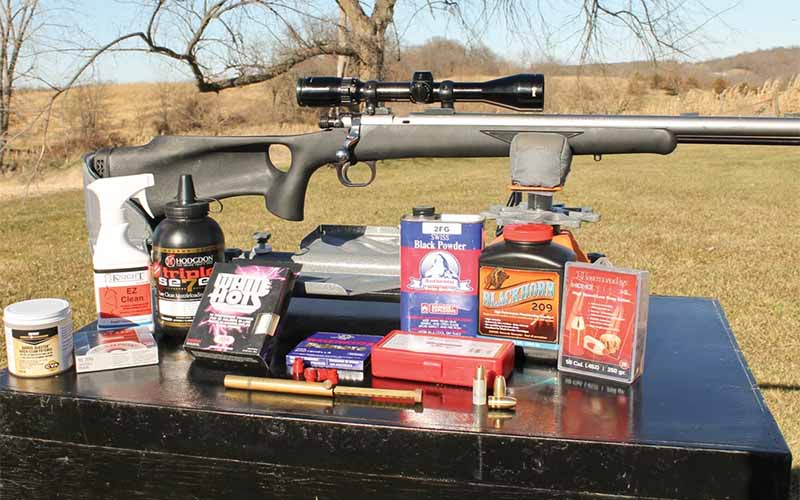
On a modern in-line you’ll need to spend a bit more time cleaning, but most have a removable breech that you can take out to clean the barrel back-to-front. Many people unscrew the breech plug, soak it in hot water and soap, and run a hose through the barrel to flush out the residue. Cleaning even a modern in-line shouldn’t take longer than fifteen minutes, though care must be taken on new rifles to avoid getting harsh chemicals and soap on your optics and finish.
If hunting, it is a good idea to fire a fouling shot to help season the bore and blow out oils and grease. This of course means that you’ll be hunting with a ‘dirty’ gun, but your odds of making a first-round hit on a clean barrel are low, as that shot can occasionally be thrown inches off zero. Some hunters will discharge their muzzleloader at the end of each day hunting and reload it in the morning. There is debate over whether it is necessary to go this route, but if you’re not in an especially humid or wet part of the country there isn’t a particular need to discharge the gun as soon as you’re done for the night. Many people just remove the cap and leave the charge in the barrel for their next sit.
For long-term storage you should store all muzzleloader types with the bore wiped down heavily in a protective oil as well as all the internals of the action itself. Even on a flintlock or percussion gun it is a good idea to fully disassemble it at the end of the season and to clean and oil all parts. The most damage the average muzzleloader will accumulate is not going to be in the field, rather it is when left to sit for months at a time.
Best Muzzleloaders For The Hunt:
CVA Paramount Pro .40-Caliber
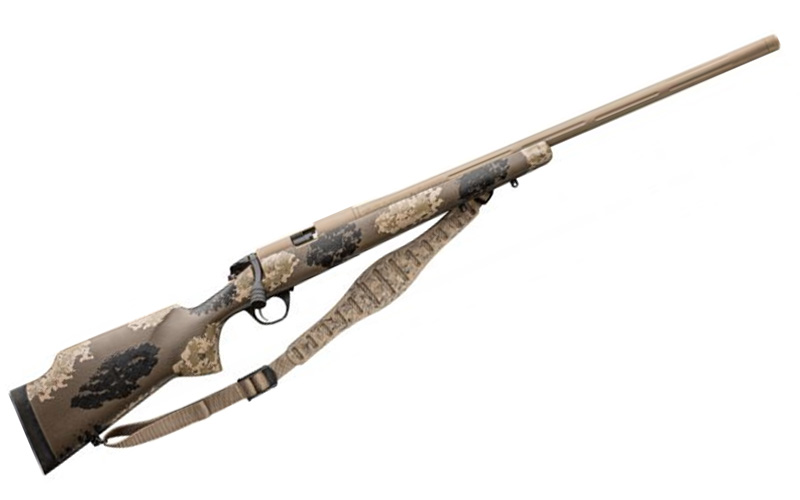
The CVA Paramount Pro is one of the most (if not THE most) advanced muzzleloaders currently made. CVA has spent a tremendous amount of effort into perfecting not just the design of the muzzleloader itself, but also the bullets it fires. It is designed around the new .40-caliber PowerBelt ELR projectiles. These new loads are designed around aerodynamic profiles, enabling them to carry more energy over longer ranges with flatter trajectories than ever before. Not only is this new setup able to offer a dramatic ballistic advantage, it does so with even less recoil than .50- and .54-caliber versions. MSRP: $1,905 // cva.bpishopping.com.
Traditions NitroFire VAPR Twist .50-Caliber Package

Traditions is a well-established brand in the muzzleloader community and offers great products at reasonable prices. The NitroFire package features a 3-9x scope and a unique loading system. The rifle is designed to be a combination breech/muzzleloader. You will load the bullet only down the barrel until it stops on a shoulder near the breech. The action is then opened, and a self-contained Federal Firestick can be inserted followed by a 209 primer. This allows the rifle to be very consistent when loading for increased accuracy and ease of use. MSRP: $635 // traditionsfirearms.com.
Pedersoli Missouri River Hawken Percussion Rifle
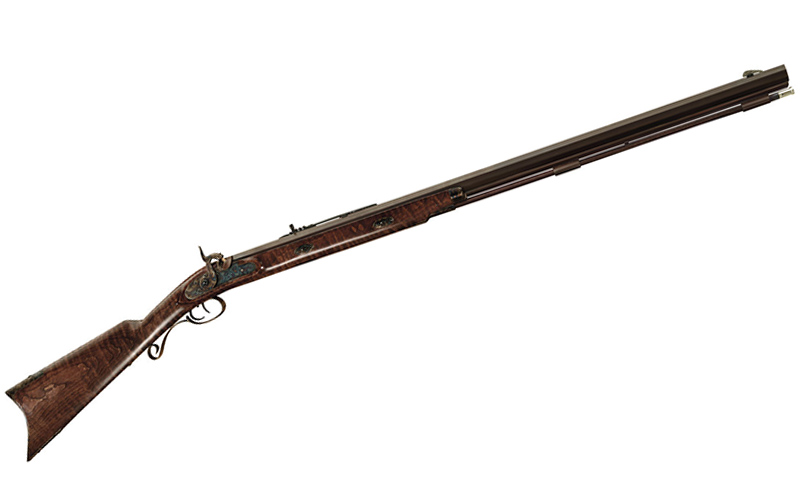
If you want to get your Jeremiah Johnson on, this traditional front-loader from Pedersoli is a faithful representation of the type of large-caliber rifle that ventured west during the 1840s and 1850s. It is bored for .45-caliber and takes standard no. 11 percussion caps making it easy to load for and become proficient with. It is an iron-sighted rifle, but thanks to its double-set triggers and heavy contour 30-inch barrel it can deliver excellent accuracy and power at 200 yards. MSRP: $1,299 // davide-perdersoli.com.
More On Muzzleloaders:
 NEXT STEP: Download Your Free Storm Tactical Printable Target Pack
NEXT STEP: Download Your Free Storm Tactical Printable Target Pack
62 Printable MOA Targets with DOT Drills – Rifle Range in YARDS This impressive target pack from our friends at Storm Tactical contains 62 printable targets for rifle and handgun range use. Target grids and bullseye sizes are in MOA. Ideal for long-range shooting! Get Free Targets


